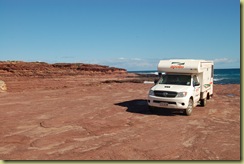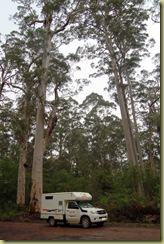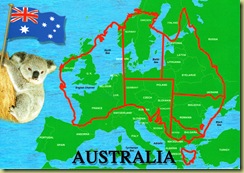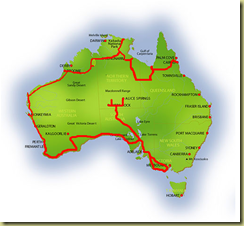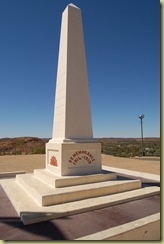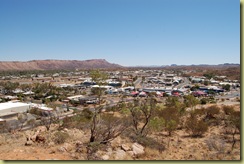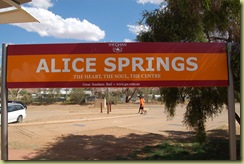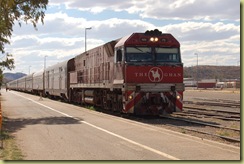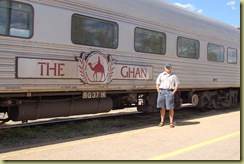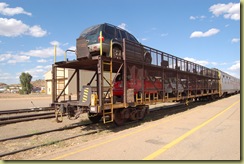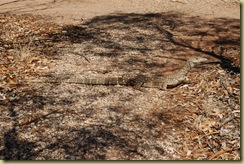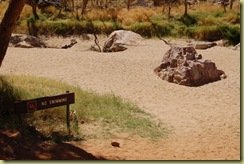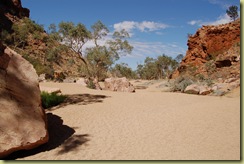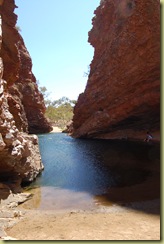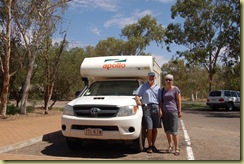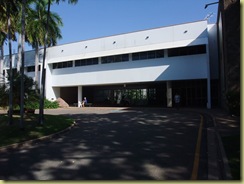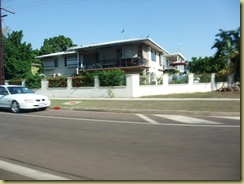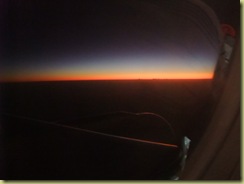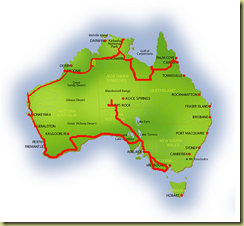
Uluru attracts around 350,000 visitors per year and although the Rock is an icon for Australia and an important sacred symbol for the local Angara Aboriginal people, that does not prevent anyone involved from regarding managing access to it as a commercial activity.
It costs $25 per person for a three day permit which allows access into the National Park within which Uluru (Ayers Rock) and Kati Tjuta (The Olgas) reside. If you want to stay overnight, you have to stay at the Ayers Rock Resort run as a monopoly by the Voyages Company, you cannot bush camp within about 50 kms of the rock and if you try to, there is a $200 fine. The campground is the most expensive we have stayed at anywhere in Australia ($38 per night) and the facilities are nothing special. If you want to pay for anything by credit card (food, petrol, camp fees etc) there is a 1% surcharge imposed since Voyages manage and run everything and can do what they like.
Having got the grumble out of the way, Uluru and Kata Tjuta are indeed very impressive and well worth visiting. In fact, can you really say you have been to Australia if you have not seen them? During our three days at Uluru and Kata Tjuta we have:
Seen sunset on Uluru from afar

Seen sunset from close up and seen the famous colour change take place. We think the colours are most impressive during the minutes before sunset
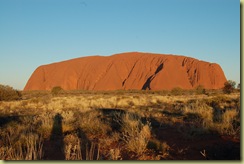
Sunset minus 30
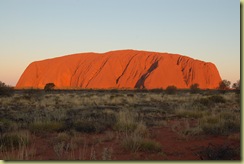
Sunset minus 15
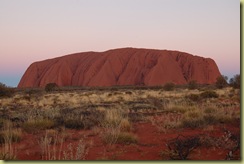
At Sunset
The surface texture is responsible for the colour change
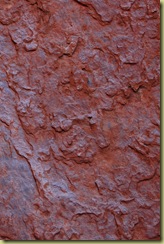
and it is described as having its origins in the rusting (or oxidising) of the normally grey sandstone.
Seen sunrise on Uluru (5.30 am get up for that one)
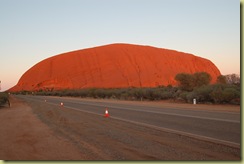
just before sunrise
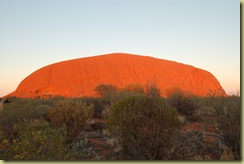
just after sunrise
Attended an excellent walk and talk given by the National Parks Service on the Aboriginal view of the origins of Uluru, aboriginal life, culture and the local environment (plus a bit of bush tucker)
The Aboriginal belief is that the world was once a featureless place. None of the places we know existed until Anangu ancestors in the form of people, plants and animals travelled widely across the land. In the process of living and travelling, they created the landscape as we know it today. As to the origins of the rock, an ancestral spirit (called Mala Tjukurpa (in the physical form of a rufous hare wallaby) came to the rock and made some caves with her claws for the Mala people to live in.
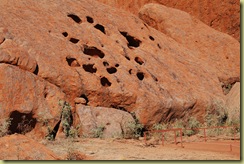
The closest we ever got to a Rufous Hare Wallaby was a stuffed one in a museum in Alice
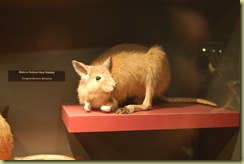
The rock was also the place where the Mala people were attacked by an evil monster called Kurpany created by another tribe (in the physical form of a black dog). Some of their number were killed and the shape of the
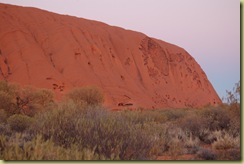
head of one of the dead men (brains, eyes, mouth etc) are clearly visible in the rock face (right hand side of the rock in the above picture)..
There are a number of pieces of Rock Art in the caves around the base and they are certainly not as good as those in Kakadu. Our guide (a senior aboriginal ranger) interpreted those he was allowed to for us
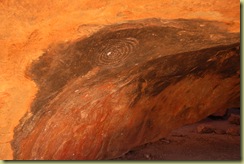
The spiral shape means “there is water nearby” – just around the corner actually!
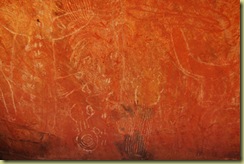
The circular shapes at the bottom of the photograph (just left of the middle) describe a group of people coming together for a meeting
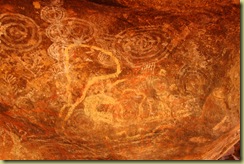
The big “C” shape just to the left of the middle means “a person sitting”, the spiral circles means “water”, the leaf shape means “a leaf”. Rock art is frequently over painted and therefore there are up to 30,000 years worth of paintings on this wall.
At the moment, anyone fit enough can climb the rock by going up a fairly challenging path. The local Aboriginals' (the Anangu people)have long been mounting a campaign to try to persuade people not to climb the rock because it is of particular spiritual significance to them. They are also concerned that when people get to the top, a number of them find a quiet spot and go to the toilet (there are no facilities on the rock). The best way of understanding their concern is to imagine that visitors to churches in the UK were to go in wearing bikinis, go to the toilet in a quite corner, play radios, eat take-away food (even deposit the ashes of dead members of their family in a handy hole in the wall).

We had decided long ago that we were not going to climb the rock and whilst here we heard that it is likely to become a thing of the past in a few months or so.
Had part of Uluru (The Mutitjulu Waterhole) to ourselves for a few minutes, we arrived just after sunrise and before anyone else had got themselves organised.
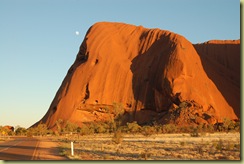
The Mutitjulu Waterhole is the home of Wanampi. an ancestral water

snake who has the power to control the source of the water in this water hole.
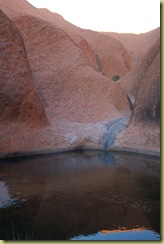
Seen Kata Tjuta (literally translated as “Many Heads) aka The Olgas and undertaken a challenging hot walk through them to a couple of lookout points.
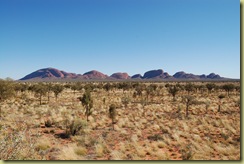
The Olgas are a group of mountains some 50 kms from Uluru of religious significance to Aboriginal men. Exactly what we are not allowed to know since we are not Aboriginal.
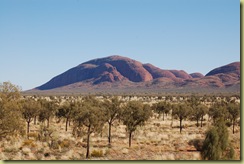
some of them look like sleeping creatures, the above is some sort of animal
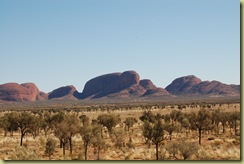
whilst this is definitely a tortoise.
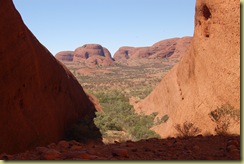
The view from the Karingana lookout – a gap between two massive rock faces looking out onto a plain between Olgas. It may not look much but it was very impressive when there and was only achieved after a long walk through the hot sun and a lot of climbing.
Been to an astronomy talk and learnt to identify the Southern Cross (and hence determine where south is), seen Jupiter and two of its moons through a telescope plus a number of stars of excitement to astronomers. For obvious reasons, there are no pictures of this.
On to Kings Canyon
About 300 kms away (a short hop now for us allowing: a lie in, a late start and arrival in time for a late lunch) is another of the great sites of the region. On the way here we see our only wild camel of the trip although
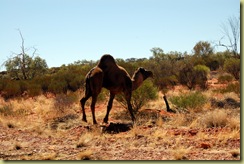
they say there are over 2 million of them in Central Australia. We also pass Mount Connor (an impressive table top mountain)
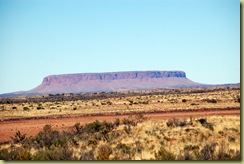
and purely for our own remembrance, another of the thousands of signs we have passed indicating that we are driving over or through a creek, most often dry although sometimes wet.
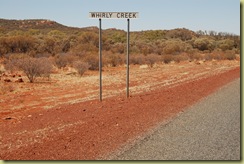
Kings Canyon is (not unsurprisingly) a Canyon of majestic proportions and from afar, its profile has the look of the Grand Canyon. We are allowed to choose our own camp site and therefore we manage to get one where the back window of the van overlooks the Canyon face. The pitch is also
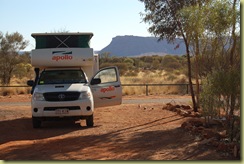
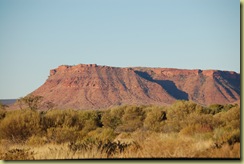
close to the toilets which is of particular value at night because Dingoes are a problem here and the toilets come equipped with a Dingo Gate (to keep them out rather than let them in) and Dingoes start to patrol the camp
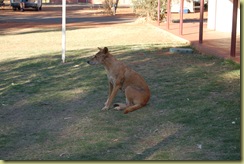
site from dusk onwards, completely ignoring any attempts to frighten then away. The general advice is never to feed a dingo (deliberately or accidently by leaving food out) and to keep well away from them.
Kings Canyon is known for an arduous walk around the rim of the canyon with fantastic views over the surrounding land and a couple of other easier walks, plus being a long way from anywhere else and a long way out into the bush. You are advised to start early and take significant quantities of water with you because much of the walk is very exposed to the sun.
The walk involves a steep climb up the canyon wall (635 steps) and then a
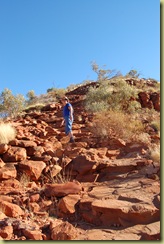
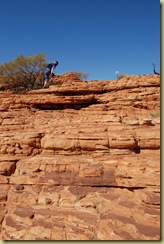
walk around the top of the canyon which weaves through sandstone
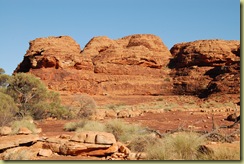
pinnacles very similar to those of the Bungles. The views over the canyon are quite spectacular both looking outwards
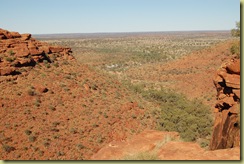
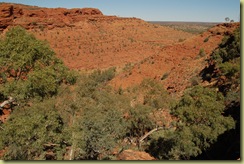
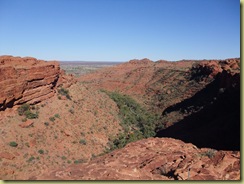
and looking inwards
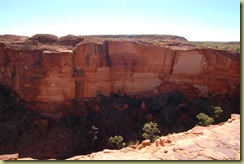
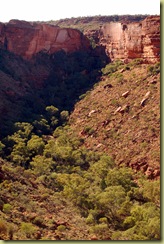
from observation points very high and exposed
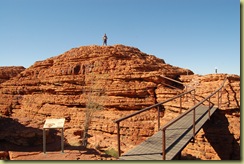
Particularly challenging (and quite spectacular) are some of the walkways which have had to be built to enable walkers to get around the rim
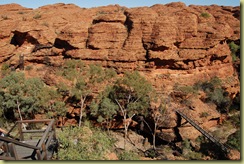
Here you come through the canyon wall top left, proceed along a walkway and then across a bridge (bottom right) along another walkway and then up some steep stairs.
The ability of plant life to establish itself and then survive in such tough
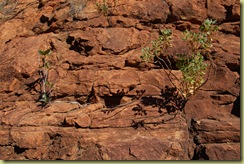
conditions is quite astonishing. This plant is determined to survive and having started growing is sending out long roots in order to eventually
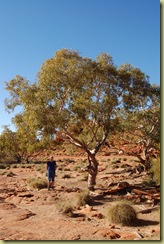
become a tree – to do so it has to send down roots a long way into the sandstone. Some water pools exist but they rapidly evaporate in the high
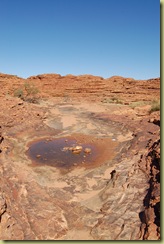
temperatures on the canyon top. Where there is shade and water, significant plant growth survives such as in the “Garden of Eden”.
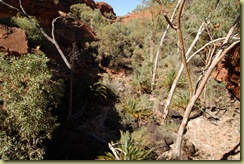
Nearby Kathleen Springs at the end of a short Gorge, is an example of
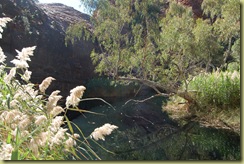
how Aboriginals used to make use of the landscape to survive by trapping the animals (kangaroos, emus etc) which came into the gorge to drink and later how settlers used the same features to manage their stock.
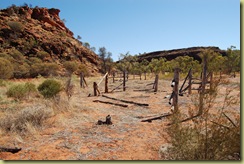
All that is left of the settlers presence is part of their stockyard. Aboriginals also believe that the pool is the home of Inturrkunya (pronounced un-door-goon-you), the Carpet Snake who came to the gorge and rested during Tjukurrpa (aka Dreamtime, essentially Creation). Evidence of this comes
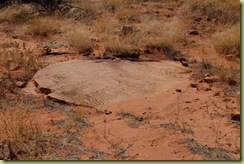
from marks preserved in stone in the gorge. We might imagine them to be ripples left by the waves which used to exist in this inland sea area millions of years ago now preserved in the sandstone – the Aboriginal view is different.
Both walks were fascinating in that although they are way out in the wilds of Australia, the Parks Service has taken great effort to provide educational
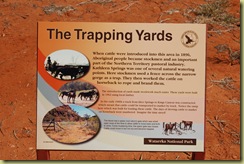
sign boards for walkers and to make the area accessible.
One of the most amazing things about Australia is that you can be on the main highway running North-South (The Stuart Highway) and not see another vehicle for miles and miles. There are occasional examples of the results of bad driving along the highway.
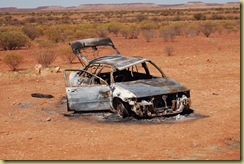
or one of the many Road Trains
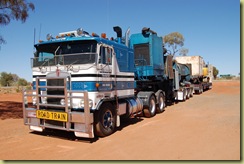
but in general, it is empty.
And so,managing to pass the above driving challenges, we get to Alice Springs for one night in a rather poor camp site followed by three days in a hotel, a chance to see the town, to hand back our van and to prepare to go home.

